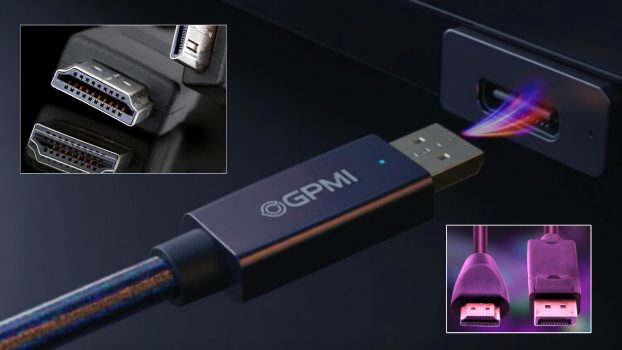 Pin
Pin China has introduced the General Purpose Media Interface (GPMI), a new cable standard developed by a consortium of over 50 Chinese companies, including Huawei, Hisense, and TCL. This initiative, led by the Shenzhen 8K UHD Video Industry Cooperation Alliance, aims to consolidate multiple functionalities—video, audio, data, and power transmission—into a single cable system. GPMI is designed to support high-performance devices such as 8K displays, gaming laptops, and augmented reality headsets, offering a unified solution that could streamline connectivity and reduce cable clutter.
The GPMI standard comes in two variants: Type-C and Type-B. The Type-C version utilizes a USB-C connector, supporting data transfer rates up to 96 Gbps and power delivery up to 240W. The Type-B version, featuring a proprietary connector, doubles these capabilities, offering up to 192 Gbps bandwidth and 480W power delivery. These specifications surpass those of existing standards like HDMI 2.1 and Thunderbolt 4, positioning GPMI as a formidable alternative in the realm of digital connectivity.
By integrating multiple signal types—including information flow, control signals, power supply, and audio/video—into a single cable, GPMI simplifies device connections and enhances efficiency. Its development reflects China’s strategic move to establish its own standards in the technology sector, potentially reducing reliance on Western technologies and licensing fees.
Table of Contents
Technical Specifications and Capabilities of GPMI
The General Purpose Media Interface (GPMI) is engineered to support the next generation of high-performance devices. It comes in two variants: Type-C and Type-B. The Type-C version utilizes a USB-C connector, supporting data transfer rates up to 96 Gbps and power delivery up to 240W. The Type-B version, featuring a proprietary connector, doubles these capabilities, offering up to 192 Gbps bandwidth and 480W power delivery.
These specifications surpass those of existing standards like HDMI 2.1 and Thunderbolt 4. For instance, HDMI 2.1 offers up to 48 Gbps bandwidth without power delivery, while Thunderbolt 4 provides 40 Gbps bandwidth and 100W power delivery. GPMI’s superior capabilities make it suitable for high-resolution displays, virtual reality headsets, and other devices requiring high data throughput and power.
Additionally, GPMI integrates multiple signal types—including information flow, control signals, power supply, and audio/video—into a single cable, simplifying device connections and enhancing efficiency. It also supports multi-channel bidirectional video transmission and mesh networking, further expanding its versatility.
Strategic Implications of GPMI for Global Connectivity
The introduction of GPMI (General Purpose Media Interface) by China signifies a strategic move to challenge the long-standing dominance of Western-developed connectivity standards such as HDMI, DisplayPort, and Thunderbolt. By offering a unified solution that combines high-speed data transfer, substantial power delivery, and versatile connectivity, GPMI positions itself as a formidable alternative in the global market. This development is not merely a technological advancement but also a statement of intent, showcasing China’s ambition to set international standards and reduce reliance on Western technologies.
GPMI’s potential to disrupt existing ecosystems is significant. Its superior specifications—supporting up to 192 Gbps bandwidth and 480W power delivery—surpass those of current standards, making it an attractive option for manufacturers aiming to streamline device connectivity. Moreover, the backing of over 50 Chinese tech giants, including Huawei, Hisense, and TCL, indicates a concerted effort to promote GPMI as a global standard. This collective push could lead to widespread adoption, especially in emerging markets where cost-effective and efficient solutions are in high demand.
However, the success of GPMI on the international stage will depend on several factors, including interoperability with existing technologies, licensing models, and the ability to gain trust among global consumers and manufacturers. If these challenges are addressed effectively, GPMI could redefine the landscape of digital connectivity, offering a new paradigm that prioritizes efficiency, versatility, and strategic autonomy.
Potential Impact of GPMI on the Global Tech Ecosystem
The emergence of China’s General Purpose Media Interface (GPMI) is poised to significantly influence the global technology landscape. By offering a unified solution that combines high-speed data transfer, substantial power delivery, and versatile connectivity, GPMI presents a compelling alternative to established standards like HDMI, DisplayPort, and Thunderbolt. This development could lead to a shift in how devices are designed, manufactured, and interconnected worldwide.
GPMI’s superior specifications—supporting up to 192 Gbps bandwidth and 480W power delivery—make it an attractive option for manufacturers aiming to streamline device connectivity. Its ability to transmit video, audio, data, and power through a single cable simplifies device connections and enhances efficiency. This could result in more compact and efficient device designs, reducing the need for multiple ports and cables.
However, the global adoption of GPMI will depend on several factors, including interoperability with existing technologies, licensing models, and the ability to gain trust among consumers and manufacturers. If these challenges are addressed effectively, GPMI could redefine the landscape of digital connectivity, offering a new paradigm that prioritizes efficiency, versatility, and strategic autonomy.
Challenges and Considerations for GPMI's Global Adoption
While China’s General Purpose Media Interface (GPMI) presents impressive technical specifications, its global adoption faces several challenges. One significant hurdle is the existing dominance of established standards like HDMI, DisplayPort, and Thunderbolt, which have widespread industry support and consumer familiarity. Transitioning to a new standard requires not only technological superiority but also convincing manufacturers and consumers to adopt a different ecosystem.
Interoperability is another concern. Devices worldwide are designed around current standards, and ensuring compatibility with GPMI would necessitate either widespread hardware changes or the development of reliable adapters, both of which could be costly and time-consuming. Additionally, the proprietary nature of GPMI’s Type-B connector may pose challenges for universal adoption, as it would require manufacturers to incorporate new hardware designs.
Geopolitical factors could influence GPMI’s acceptance. Given that GPMI is a Chinese-developed standard, some countries may be hesitant to adopt it due to concerns over technology dependence and data security. To overcome these challenges, proponents of GPMI would need to demonstrate not only its technical advantages but also address compatibility issues and build trust with international partners.
Future Outlook and Potential of GPMI in the Global Market
The General Purpose Media Interface (GPMI) represents a significant advancement in cable technology, aiming to unify various functionalities—video, audio, data, and power transmission—into a single interface. Developed by a consortium of over 50 Chinese companies, including Huawei, Hisense, and TCL, GPMI offers impressive specifications: up to 192 Gbps bandwidth and 480W power delivery in its Type-B variant, and 96 Gbps with 240W in the Type-C version. These capabilities surpass those of existing standards like HDMI 2.1 and Thunderbolt 4.
The potential for GPMI to become a global standard hinges on several factors. Firstly, its adoption within China is likely to be robust, given the backing of major domestic manufacturers. This internal support could create a substantial user base and drive further development and refinement of the standard. Secondly, GPMI’s technical advantages may attract international interest, especially in sectors requiring high data throughput and power delivery, such as gaming, virtual reality, and professional media production.
However, global adoption will depend on GPMI’s interoperability with existing technologies, the willingness of international manufacturers to incorporate the new standard, and the establishment of clear licensing and regulatory frameworks. If these challenges are addressed effectively, GPMI could redefine the landscape of digital connectivity, offering a unified solution that enhances efficiency and performance across various devices and applications.
Industry Reactions and Early Implementations of GPMI
Industry reactions to China’s new cable standard GPMI have been a mix of cautious interest and strategic curiosity. While mainstream Western media and tech giants haven’t fully embraced it yet, the move is definitely being noticed. Tech observers see GPMI not just as another cable but as part of a much larger ambition—China wanting to move from being a manufacturing hub to a standard-setting tech leader. For many global brands, this could mean rethinking how they build hardware and who they partner with.
Inside China, companies like TCL, Huawei, and Hisense are already showing interest in rolling out GPMI in their next-gen devices. There are also strong hints that GPMI could be promoted aggressively in Chinese-made monitors, TVs, and even VR headsets. If this happens, it’ll give the standard a huge test bed right at home, while also creating export-ready products built around it. If GPMI starts shipping with a range of widely used consumer electronics, it’ll force the international tech world to pay closer attention—especially if price and performance match or beat current solutions.
Economic and Political Dimensions of GPMI’s Emergence
The rise of GPMI isn’t happening in a vacuum—it’s deeply tied to the broader economic and political context of China’s ongoing push for technological self-reliance. For years, China has been dependent on Western standards like HDMI and Thunderbolt, often paying licensing fees and waiting for updates that suit global, mostly Western, timelines. GPMI is a direct response to that dependency. It’s about reducing foreign influence in Chinese tech infrastructure and increasing the country’s ability to control and set global technology standards.
Economically, GPMI has the potential to create a new export sector for China, much like what it did with 5G hardware. If Chinese-made devices using GPMI become affordable and reliable, they could undercut Western competitors, especially in developing nations. Politically, the global reception to GPMI will likely mirror how governments feel about China’s expanding tech influence. Countries wary of Chinese surveillance or data policies may hesitate to adopt it, while others might see it as a cost-effective alternative to U.S.-backed standards. Either way, GPMI is more than a tech update—it’s a geopolitical statement.
The Road Ahead for GPMI and Its Competition
Looking to the future, the success of GPMI largely depends on how it stacks up against its established competition—HDMI, DisplayPort, and Thunderbolt. These standards have been deeply ingrained in the market for years, with massive support from hardware manufacturers and widespread consumer recognition. GPMI’s rise isn’t just about offering higher speeds and better power delivery; it’s about creating a compelling ecosystem that persuades both manufacturers and consumers to make the switch.
In the short term, we can expect GPMI to make waves in markets where China has a strong foothold—particularly in Asia. The early adoption will likely come from industries such as gaming, entertainment, and professional media, where the high performance of GPMI’s bandwidth and power delivery is crucial. However, it will face stiff resistance in regions where Western standards are the norm, especially in Europe and North America, where market inertia and brand loyalty play a significant role.
To truly compete, GPMI will need to demonstrate seamless interoperability with existing systems and overcome any initial skepticism from consumers and manufacturers. If it can combine these technical merits with strong global partnerships and competitive pricing, it might stand a chance of becoming a major player in the future of digital connectivity.
FAQs
GPMI (General Purpose Media Interface) is a new cable standard developed by China to unify data, video, audio, and power transmission into a single cable. Unlike HDMI, DisplayPort, and Thunderbolt, GPMI offers superior data transfer rates of up to 192 Gbps and power delivery of 480W, making it suitable for high-performance devices like 8K displays and gaming laptops.
GPMI surpasses HDMI and Thunderbolt in bandwidth and power delivery. The Type-B version of GPMI offers up to 192 Gbps bandwidth and 480W of power, whereas HDMI 2.1 supports only 48 Gbps, and Thunderbolt 4 offers 40 Gbps and 100W power. This makes GPMI ideal for future-proof, high-demand applications like VR and 8K displays.
GPMI is supported by over 50 Chinese companies, including major tech giants such as Huawei, Hisense, and TCL. This strong domestic backing positions GPMI as a serious contender in the global tech landscape, with the potential to challenge Western standards.
While GPMI offers significant technical advantages, its compatibility with current devices remains a concern. To ensure global adoption, GPMI would need to integrate seamlessly with existing systems, which may require the development of adapters or new hardware designs by manufacturers.
GPMI has the potential to disrupt the global connectivity market by offering a unified solution that reduces cable clutter and simplifies device connections. However, its success depends on overcoming challenges related to interoperability, market adoption, and geopolitical concerns, particularly as countries may have reservations about embracing a China-developed standard.




























